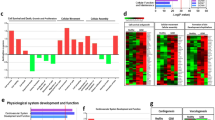Abstract
Thalidomide is a sedative, hypnotic, and anti-inflammatory medicine. However, exposure during the pregnancy is known to cause several developmental disorders. The most fearful side-effects are teratogenicity and neuropathy. Development is a highly coordinated set of processes that depend on hierarchies of signaling and gene regulatory networks, and the disruption of such networks may underlie many cases of chemically induced birth defects. In this research, we compared the global gene expression responses by thalidomide in human placenta choriocarcinoma cell line (JEG-3) by using agilent human whole genome chip. Through the analysis of gene expression profiles, we identified 167 up-regulated genes and 56 down-regulated genes changed by thalidomide by more than 1.5-fold. And also functions related to genes expressed by thalidomide were apoptosis, angiogenesis, and cell adhesion. In summary, we examined genes and functions associated with teratogenic effects of thalidomide using global expression profiling and functional analysis. Thus, our data suggest that thalidomide may block angiogenesis signal pathway through inactivation of cell adhesion, and these anti-angiogenesis may be affected limb development.
Similar content being viewed by others
References
Sauer, H., Gunther, J., Hescheler, J. & Wartenberg, M. Thalidomid inhibits angiogenesis in embryoid bodies by the generation of hydroxyl radicals. Am. J. Pathol. 156, 151–158 (2000).
McBride, W.G. Thalidomide and congenital abnormalities. Lancet 2, 1358 (1961).
Lenz, W. & Knapp, K. Thalidomide embryopathy. Arch. Environ. Health 5, 100–105 (1962).
Breitkreutz, I. & Anderson, K.C. Thalidomide in multiple myeloma-clinical trials and aspects of drug metabolism and toxicity. Expert Opin. Drug Metab. Toxicol. 4, 973–985 (2008).
Zeldis, J.B., Williams, B.A., Thomas, S.D. & Elsayed, M.E. S.T.E.P.S.: A comprehensive program for controlling and monitoring access to thalidomide. Clin. Ther. 21, 319–330 (1999).
Stephens, T.D. & Fillmore, B.J. Hypothesis: thalidomide embryopathy-proposed mechanism of action. Teratology 61, 189–195 (2000).
Meise, W., Ockenfels, H. & Köhler, F. Teratologische prufung der hydrolysenprodukte des thalidomids. Experientia 29, 423–424 (1973).
Kenyon, B.M., Browne, F. & D’Amato, R.J. Effects of thalidomide and related metabolites in a mouse corneal model of neovascularization. Exp. Eye. Res. 64, 971–978 (1997).
Kim, Y.J. et al. Differential gene expression induced by naphthalene in two human cell line, HepG2 and HL-60. Mol. Cell. Toxicol. 5, 99–107 (2009).
Bae, H.J. et al. Decreased expression of the suppressor of cytokine signaling 6 in human hepatocellular carcinoma. Mol. Cell. Toxicol. 5, 193–197 (2009).
Reynolds, L.P. & Redmer, D.A. Angiogenesis in the placenta. Biol. Reprod. 64, 1033–1040 (2001).
Geduspan, J.S. & Solursh, M. Effects of the mesonephros and insulin-like growth factor-I on chondrogenesis of limb explants. Devl. Biol. 156, 500–508 (1993).
Dealy, C.N. & Kosher, R.A. IGF-I, insulin and FGFs induce outgrowth of the limb buds of amelic mutant chick embryos. Development 122, 1323–1330 (1996).
Bischoff, J. Cell adhesion and angiogenesis. J. Clin. Invest. 99, 373–376 (1997).
Stephens, T.D., Bunde, C.J. & Fillmore, B.J. Mechanism of action in thalidomide teratogenesis. Biochem. Pharmacol. 59, 1489–1499 (2000).
Beauvais, D.M., Ell, B.J., McWhorter, A.R. & Rapraeger, A.C. Syndecan-1 regulates alphavbeta3 and alphavbeta5 integrin activation during angiogenesis and is blocked by synstatin, a novel peptide inhibitor. J. Exp. Med. 206, 691–705 (2009).
Mosmann, T. Rapid colorimetric assay for cellular growth and survival: application to proliferation and cytotoxicity assays. J. Immunol. Methods 65, 55–63 (1983).
Tusher, V.G., Tibshirani, R. & Chu, G. Significance analysis of microarrays applied to the ionizing radiation response. Proc. Natl. Acad. Sci. U.S.A. 98, 5116–5121 (2001).
Author information
Authors and Affiliations
Corresponding author
Rights and permissions
About this article
Cite this article
Kim, YJ., Lee, J. & Ryu, JC. Altered gene expression and functions in thalidomide-treated human placenta choriocarcinoma (JEG-3) cells. BioChip J 4, 22–29 (2010). https://doi.org/10.1007/s13206-010-4104-1
Received:
Accepted:
Published:
Issue Date:
DOI: https://doi.org/10.1007/s13206-010-4104-1




